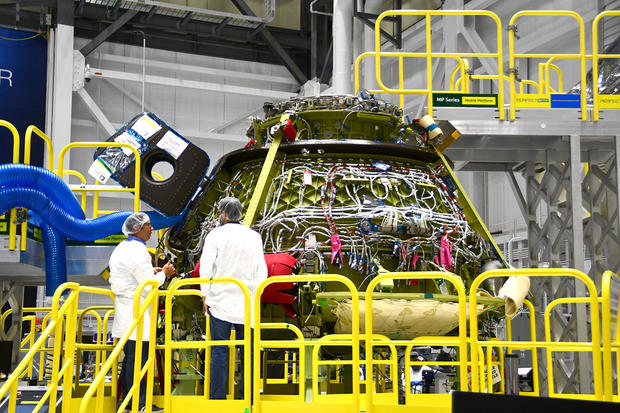Boeing orders another delay for first piloted flight of its troubled Starliner spacecraft
The first piloted flight of Boeing’s problem-plagued Starliner spacecraft, already years behind schedule and an unexpected also-ran behind SpaceX’s Crew Dragon, is slipping from late July to later this year — or next — because of newly-discovered parachute and wiring issues.
It was the latest in a series of disappointments for veteran astronauts Barry “Butch” Wilmore and Sunita Williams, who had planned to blast off atop a United Launch Alliance Atlas 5 rocket on July 21 for the Starliner’s third flight to the International Space Station and its first with a crew on board.
But during a series of reviews over the last two weeks to clear the way for spacecraft fueling, engineers ran into two issues that could not be resolved in time: weaker-than-expected “soft links” that connect parachute suspension lines to the spacecraft; and tape wrapped around electrical lines that use a flammable adhesive.
Boeing
Testing and analysis showed the soft links had been incorrectly analyzed earlier and did not have the required factor-of-two safety margin in scenarios where the loss of a parachute for any reason could overload one or more soft links used by the two remaining parachutes.
The tape flammability issue could prove especially challenging because several hundred feet or more are used throughout the Starliner to protect wire harnesses from chafing or other damage. Boeing must now make sure a short circuit or some other ignition source cannot trigger a fire.
Why the problems were not caught earlier is not yet clear.
“Over the last week, we’ve been working to understand these issues,” said Mark Nappi, Boeing’s Starliner program manager. He said the company carried out tests and analyses to find out if the risks were acceptable “or was it something that would require modifications or further work?”
“This reached the top levels of Boeing,” he told reporters in an afternoon teleconference, “all the way up to our CEO. Boeing unanimously decided that this was something we needed to correct … and we’ve decided to stand down the preparation for the CFT (Crew Flight Test) mission in order to correct these problems.”
A new launch target was not specified and while Nappi said a flight this year was “feasible,” it appeared unlikely given the amount of work and re-testing that will be required.
Steve Stich, NASA manager of the Commercial Crew Program, said Wilmore and Williams sat in on an all-hands meeting to discuss the issues and were in agreement with the decision to stand down.
“This team will solve these problems and we’ll go fly when we’re ready,” Stich said. “Suni Williams was representing the crew and she voiced that (they) are 100% behind the decision. They understand that the team has crew safety first and foremost in their minds and they’ll fly … when the vehicle’s ready to go fly.”
The Starliner’s troubled history is surprising to many because of Boeing’s reputation as a leader in human spaceflight, building the first stage of the legendary Saturn 5 rocket and its successor, the Space Launch System moon rocket, and serving as the International Space Station’s prime contractor.
William Harwood/CBS News
In 2014, Boeing and SpaceX won NASA contracts valued at a combined $6.8 billion to build commercial crew ships that could carry NASA and partner-agency astronauts to and from the space station. The contracts covered up to six flights per company, plus one crewed and one uncrewed test flight.
SpaceX, under an initial $2.6 billion contract, designed a crewed version of its Dragon cargo ship that would ride into orbit atop the company’s Falcon 9 rocket. Boeing designed its own capsule — Starliner — under a $4.2 billion contract, relying on the Atlas 5 for the trip to orbit.
After a successful unpiloted test flight, SpaceX launched a two-man crew to the space station in May 2020 — three years ago this week — for the first piloted test flight. The company has now launched 10 piloted Crew Dragon missions, seven for NASA and three privately funded flights, boosting 38 astronauts, cosmonauts and civilians to orbit.
Boeing had hoped to launch its first crew in 2020 as well, but the company ran into major software problems during an unpiloted test flight in December 2019. Before a second uncrewed test flight could be launched, engineers ran into trouble with corroded propulsion system valves, delaying the flight to May 2022.
The second time around, the Starliner completed its major objectives, robotically docking with the space station as planned and safely returning to a parachute-assisted touchdown in Utah. At that point, NASA was aiming for a piloted launch late last year.
But additional analysis and reviews pushed the flight into 2023 and this past April, launch was delayed to no earlier than July 21 to give engineers more time to review paperwork and analysis and carry out more tests. That work was nearing completion when the parachute and wiring issues cropped up.
In the meantime, NASA extended SpaceX’s initial six-flight contract to 14, providing astronaut ferry flights to the station through 2026. Boeing’s contract has not been extended beyond the initial six crew rotation flights booked in 2014. Nappi said the company is absorbing the costs of the delays.
Despite the delays, Stich said NASA is counting on the Starliner to provide assured access to the International Space Station through the end of the decade.
“There’s an unwavering commitment to Starliner and to having a second crew transportation system,” he said.
“Our ultimate goal is to have one SpaceX and one Boeing flight per year to rotate our crews to station. And so we support Boeing, and we’re doing everything we can during the investigation of each of these issues and trying to get to flight as soon as we can when it’s safe to do so.”
For all the latest Automobiles News Click Here
For the latest news and updates, follow us on Google News.




